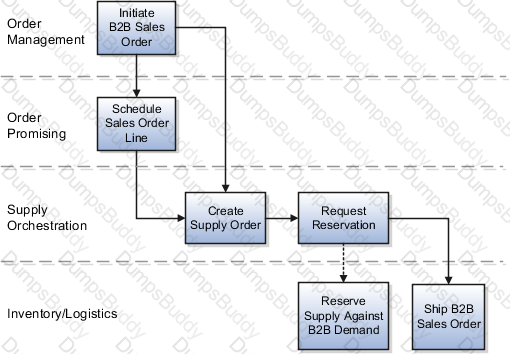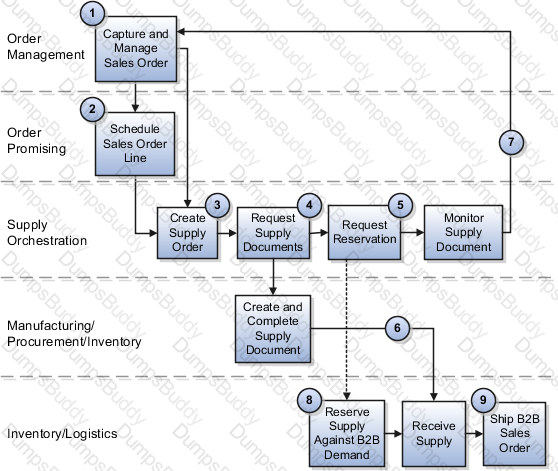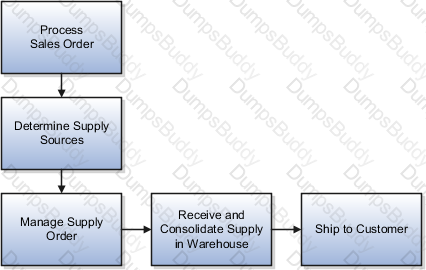Back-to-Back Supply Creation On-Hand Flow
The back-to-back on-hand available (ATP) flow is the simplest in terms of the number of steps that constitute the flow. This flow occurs where on hand supply is available in the fulfillment warehouse for the ordered back-to-back item at the time of order promising. Because on-hand goods already exist in the form of on hand, Oracle Supply Chain Orchestration directly sends a request to reserve the on hand quantity against the back-to-back sales order. You can ship the sales order immediately after the reservation is created.
The following figure shows the back-to-back supply creation on-hand flow.

How Back-to-Back Fulfillment Works
The back-to-back process flow is one in which specific sales order demand triggers supply creation and a link is established between the sales order and the supply.
An organization procures goods from an internal or external supplier or source to a specific warehouse from where you can combine those goods with others to create a single shipment to the customer.
Back-to-back supply processes are similar to regular supply processes that deliver supply to a warehouse except for one difference; the back-to-back supply is always reserved to an order management fulfillment line.
At a high level, you can think of back-to-back fulfillment as a three-step process:
1.Creation of a customer sales order (source of demand).
2.Creation and fulfillment of supply document (source of supply) to the fulfillment warehouse.
3.Shipment of sales order from the fulfillment warehouse to the customer.
However, the back-to-back flow is truly a highly integrated process flow involving several Oracle Fusion Cloud applications. The following figure shows the back-to-back process flow in detail. An explanation for each number follows the figure.

Back to Back fulfillment
Overview of Back-to-Back Fulfillment
The back-to-back fulfillment process is one in which specific sales order demand triggers supply creation, and a link is established between the sales order and the supply.
Note: Back-to-back flow is currently supported only for discrete manufacturing.
The following figure provides a high-level flow diagram showing the back-to-back supply creation and fulfillment process flow.

Back-to-back fulfillment is where supply is procured and then received at a warehouse only after an order is placed.
The supply is reserved against a sales order until shipping.
This process provides support to create and link supply after a sales order is entered and scheduled, allowing you to reduce your inventory while maintaining the ability to respond to customer demands.
You create supply for a back-to-back order using one or more of the following back-to-back flows:
•Buy: Procurement from an external supplier.
•Make: Production in an internal manufacturing facility (includes in-house manufacturing and contract manufacturing).
•Transfer: Transfer from another warehouse.
•On hand: Reservation of on-hand supply in the fulfillment organization.
Note: For information about back-to-back flows for contract manufacturing, see the Implementing Contract Manufacturing chapter in this guide.
After the supply is received into the fulfillment warehouse, the back-to-back order is ready for shipment to the customer.
Your customer wants to track and approve inventory transactions between two inventory organizations handling high value goods.
What are the two types of inventory transactions recommended?
Your consumption advice frequency is weekly and the billing cycle closing date is November 7, 2022. What happens when the Create Consumption Advice process is run on November 10, 2022?
Your warehouse manager is unable to find the transfer order in the return receipt task. What could be the reason for this?
You are planning to create a new transaction type, Audit Movement, to track all inventory movements planned for periodical audit in your warehouse.Which statement is true about the Audit Movement transaction type?
The Supply Chain Orchestration Work Area Supply Line Overview page displays supply lines that are aggregated and grouped. Which of the following form the group? (Choose four)
Which configuration determines whether transfer is executed using Transfer Order or Purchase Order?
Your customer manages all the procurement and warehouse operations in the US and has decided to create a US business unit for this purpose.
Which two mandatory pieces of information are required to create a US business unit?
What can your supplier invoices, created through spreadsheet upload for consigned inventory, be matched against?
Your customer operates in both the US and UK and wants financial reporting in two different financial reporting standards.How many primary ledgers should be set up to fulfill this requirement?
The interorganization parameter is not set up completely.Shipment numbers are not generated for transfers using direct organization transfer.Your customer has decided to implement dual UOM tracking for an inventory organization.
Which two statements are FALSE about dual UOM tracking?